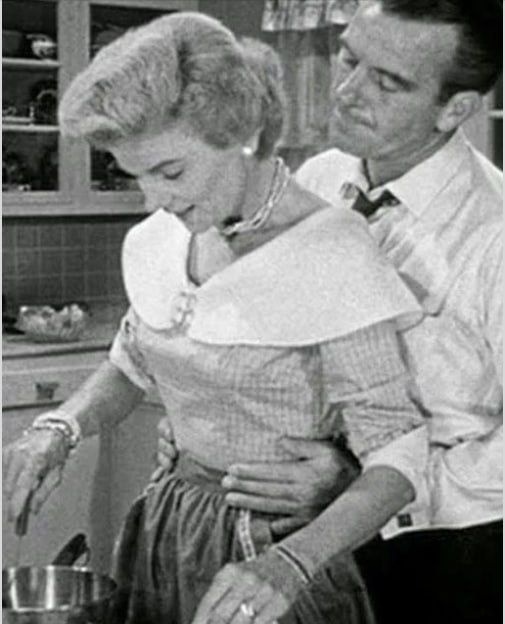If the world mirrored the wholesome charm of Leave It to Beaver, it would surely be a much brighter place.
However, as with anything perfect, there are a few bumps in the road. Leave It to Beaver wasn’t immune to its share of behind-the-scenes slip-ups and hidden quirks that even the most devoted fans might have missed.
Set a Higher Standard
Although Leave It to Beaver centered on a fictional family, it raised the bar for moral integrity, setting a higher standard for American television. It stood in stark contrast to many shows that have gradually lost that same level of quality over the years.
This beloved American sitcom, which aired from 1957 to 1963, captured the hearts of audiences with its portrayal of ideal family values and wholesome entertainment, becoming a timeless classic in the process.

In simple terms, the series was brilliantly crafted and downright hilarious.
Now, let’s take a fun dive into some unintentional moments that slipped through the cracks—what we commonly call bloopers or goofs. One particular scene caught me off guard, as it remained unedited and left a surprising blooper on screen.
June Cleaver’s Busy Schedule
One of the most amusing and little-known mistakes revolves around June Cleaver’s schedule. For years, the Cleaver household has been the epitome of perfect housekeeping.
Of course, every meticulously organized home has a calendar to keep track of important dates. June Cleaver was no exception, proudly displaying her calendar on the wall. But here’s the catch — it seems the calendar was never updated! This little detail slipped by unnoticed, adding an unintentional touch of humor to the otherwise picture-perfect home.

For those with a keen eye, you might have noticed an amusing slip-up in June Cleaver’s calendar during the episode The Poor Loser (1963). The dates displayed were completely off, suggesting the crew accidentally used a calendar from 1961 instead.
But that’s not all! In the same episode, when Ward and Beaver plan to attend a baseball game, there’s another blooper tucked away. In a close-up shot of their tickets, the town name “Mayfield” is misspelled as “Mayfied” in the smaller font, despite being spelled correctly in the larger font. A classic case of oversight that slipped past the sharpest of viewers!
The Faux Bee
Back in the day, special effects were nowhere near as sophisticated as they are today, so filmmakers had to get creative with more hands-on techniques. If you recall the episode The Silent Treatment, there’s a scene where Beaver is painting a door and suddenly gets distracted by a bee.
Instead of risking a real bee on set, the crew went with a fake one suspended on a string. If you watch closely, you can spot the string gently swaying in the air right near Beaver’s face — a charming little behind-the-scenes quirk!
Jerry Mathers Reflects on His Role
Jerry Mathers, who played Theodore “Beaver” Cleaver, became the iconic TV little brother loved by audiences everywhere. As he celebrated his 76th birthday in 2024, he’s still going strong and full of life.
When asked if his real-life persona reflected any of Beaver’s traits, Jerry had a lighthearted answer:
“Well, I got into a lot less trouble,” he laughed. “But then again, I had a lot of people watching me all the time. There were about 60 men and maybe eight or nine women on set — lighting technicians and various crew members. During breaks, when I wasn’t filming, they’d come out and we’d play catch with footballs and baseballs. It was like one big extended family. There were so many people around, and they didn’t want to hear me say, ‘I don’t want to be here anymore.’”
Jerry Mathers’ Unforgettable Audition
When it comes to Jerry Mathers, his audition for the role of Beaver is a story that can’t be overlooked — and for good reason. It was one for the books, making a lasting impression on everyone involved.
“I showed up in my Cub Scout uniform, so that should’ve been a pretty big clue,” Mathers recalled with a chuckle.
At the time, Jerry was more focused on getting to his Cub Scout meeting than the audition itself, and he wasn’t exactly thrilled about being there. But despite his initial reluctance, he quickly won over the show’s creators, Joe Connolly and Bob Mosher, with his natural charm, innocence, and perfect delivery of the dialogue. It was clear that they had found their Beaver in an instant.

Jerry Mathers’ Candid Charm
Jerry Mathers didn’t hold back in expressing his concerns about missing his Cub Scouts meeting, which only added to his irresistible charm. His honesty was refreshing, and the producers immediately knew they had found their perfect Beaver.
Ironically, after securing the role, Jerry didn’t have much time left for scouting.
“We had to attend school for three hours a day, but it was broken up. We’d shoot the long shots first, then head back for close-ups. You’d constantly be in and out of school — studying for 20 minutes, then running off to film another scene,” Jerry explained, giving us a peek behind the curtain of his busy schedule.
A Negotiating Genius
Jerry Mathers wasn’t just a talented actor — he was also a savvy businessman. He made history as the first child actor to negotiate a deal that entitled him to a share of the merchandising profits from the show. Talk about forward-thinking!
This shrewd business move turned out to be a goldmine, as Leave It to Beaver continues to generate revenue more than six decades after its original airing. Who could’ve predicted that a show about a young boy in a striped shirt and his everyday adventures would keep raking in profits long after the credits rolled?
Tony Dow Wasn’t Always Wally
Tony Dow, beloved for his role as Wally Cleaver, the quintessential big brother to Theodore “Beaver” Cleaver, didn’t always have the role locked in. Wally, the All-American older sibling, navigated the ups and downs of teen life, from dating dilemmas to offering wisdom to his mischievous younger brother.
While Tony Dow made the character iconic, Wally Cleaver wasn’t initially his role, adding another layer of behind-the-scenes intrigue to the show’s history.

Tony Dow’s Legendary Wally
Tony Dow’s portrayal of Wally Cleaver became iconic, thanks to his charm, warmth, and everyman appeal. He brought the relatable, all-American older brother to life in a way that made Wally a household name. But did you know that Tony wasn’t the first actor cast in the role?
In the pilot episode, Paul Sullivan originally played Wally Cleaver. However, he was replaced when a sudden growth spurt made him appear too mature for the role, leaving Tony Dow to step in and become the beloved big brother we all know.
June Cleaver’s Hidden Scar
Barbara Billingsley, forever remembered for her role as June Cleaver, set the standard for the perfect, poised TV mom. She’s often pictured vacuuming the living room, impeccably dressed in pearls and high heels, embodying a sense of grace and composure that defined the character.
But behind her flawless image, Barbara Billingsley had a secret — a hidden scar. It wasn’t something she often discussed, but it adds an interesting layer to her real-life persona, showing that even the perfect mom had her own personal story beyond the screen.

Behind June Cleaver’s Iconic Look
In one iconic publicity still, Hugh Beaumont and Barbara Billingsley share a kiss, embodying the loving Ward and June Cleaver. But there’s more to June’s signature look than meets the eye. Barbara Billingsley actually wore her iconic pearls to cleverly conceal a surgical scar at the back of her neck, something she preferred to keep hidden from the public. As for the high heels, they weren’t just for style — they were a practical choice to help Barbara maintain stature parity with her rapidly growing on-screen sons.
Did Jerry Mathers and Tony Dow See Eye to Eye?
Looking through photos from the Leave It to Beaver set, it’s clear that Jerry Mathers and Tony Dow had a strong bond, both on and off screen. Their chemistry as Beaver and Wally was undeniable.
In a 2006 conversation with the Television Academy Foundation, Jerry reflected on their relationship:
“Wally is the perfect older brother,” Jerry explained. “He’s the best at basketball, football, and everything else. He’s a big-time letterman, acing all his papers, and everyone loves him.”
It’s clear that while Jerry’s character, Beaver, may have looked up to Wally on-screen, the two actors shared a genuine camaraderie that made their sibling relationship even more believable.

A Real-Life Sibling Bond
The connection between Tony Dow and Jerry Mathers wasn’t just limited to their on-screen sibling dynamic — their genuine friendship radiated through their performances, enhancing the depth of their characters. The authenticity of their bond, conveyed through glances and body language, resonated deeply with audiences. It’s rare to see sibling dynamics portrayed with such sincerity, and their real-life friendship made it all the more believable.
For those curious about the behind-the-scenes camaraderie, Tony and Jerry truly became best friends during the Leave It to Beaver filming. They maintained that close friendship throughout their lives, and after Tony’s passing in 2022, Jerry shared his heartfelt sadness: “He was not just my TV brother, but in many ways, my brother in life too. Tony leaves a void in my heart that can never be filled.”
The Vietnam Rumor
A surprising rumor once circulated that Jerry Mathers had died in Vietnam, but thankfully, it was entirely fabricated. The truth is that Jerry never set foot in Vietnam. Though he initially tried to enlist in the Marines, he was rejected due to concerns that his death while overseas would create negative publicity. Instead, Jerry served in the Air National Guard, where his duties were limited to the United States.
The Most Expensive Episode
One of Leave It to Beaver’s most iconic episodes aired on May 5, 1961. In this memorable scene, Beaver attempts to prove that there’s no soup in a giant cup on a billboard, only to fall into it. This particular episode ended up costing a hefty $40,000 to produce, making it the priciest of the entire series. It also became one of Jerry Mathers’ most unforgettable moments, as he had to face his fear of heights (acrophobia) during filming.
A Groundbreaking Moment
Leave It to Beaver broke new ground in many ways, one of which was its unique focus on the children’s perspective, allowing viewers to relate more deeply to the characters. Another groundbreaking element was the show’s attention to everyday family life, illustrating the mundane yet significant moments that make up a family’s world.
A standout moment in this regard came when Wally was seen carrying a toilet seat — an unexpected, yet significant piece of everyday life that marked a notable moment in television history. The show’s ability to highlight such ordinary details helped it stand out as a truly innovative series.

Breaking TV Taboos
Even when only the tank was visible, Leave It to Beaver was one of the first shows to hint at a bathroom scene. During the 1950s, networks were highly resistant to displaying bathrooms on television, let alone showcasing an actual toilet.
The Premiere Episode Almost Didn’t Air
In fact, the very first episode of Leave It to Beaver nearly didn’t air due to its controversial content involving an alligator and a bathroom scene — both of which were considered taboo for TV at the time.
In the episode, Wally and Beaver decide to get a pet alligator. Jerry Mathers recalled, “We wanted to put it in the toilet because we knew alligators needed water. At the time, not only was showing a toilet forbidden, but showing any kind of bathroom was too.” The show’s producers clashed with censors for the inclusion of the bathroom scene, eventually settling on showing only the back of the toilet tank. “That’s how Leave It to Beaver set some benchmarks for television,” Mathers explained in a conversation with Fox News. “We were the first series to show a bathroom.”
A Different Approach to Comedy
Unlike many sitcoms of the time, Leave It to Beaver didn’t rely on loud, exaggerated laughter. The creators aimed for a mild comedic tone, with humor that came naturally from the characters and their interactions.
This approach helped shape the show’s unique atmosphere, fostering a friendly and family-oriented vibe. Producers wanted humor to emerge organically, avoiding forced jokes or over-the-top comedic moments. As Tony Dow put it, “If any line got too much laughter, they’d cut it out.”
A Timeless Legacy
As we wrap up our exploration of Leave It to Beaver, it’s clear that this iconic sitcom was more than just a portrayal of family life in the ’50s and ’60s. It was a rich blend of humor, quirky moments, and unforgettable bloopers.
So, the next time you sit down to watch Leave It to Beaver, remember those hidden gems that make it even more special. After all, who doesn’t love a good blooper? Share your favorite bloopers and funny moments with us on social media — we can’t wait to hear about the moments that brought a smile to your face!
Here’s to the joy, the memories, and the lasting charm of Leave It to Beaver!


